American film actor Mickey Rooney (1920-2014) had one of the longest careers in cinematic history. As a child, he first appeared on film in 1926 and he made his last appearance in 2014. As a teenager, Rooney was a superstar playing Andy Hardy in a series of 15 films in the 1930s and 1940s that epitomised American family values. With Judy Garland, he became a successful song-and-dance team. Rooney's breakthrough-role as a dramatic actor came in Boys Town (1938) opposite Spencer Tracy as Father Flanagan.The popularity of his films made Rooney the biggest box-office draw in 1939, 1940 and 1941.
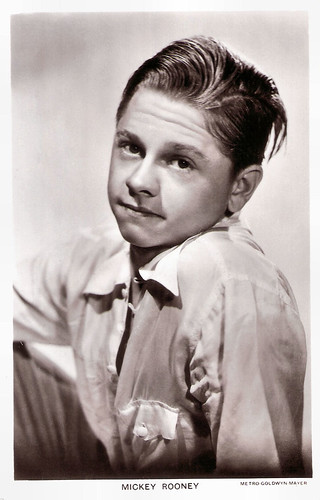
British postcard in the Picturegoer Series, London, no. 902a. Photo: Metro-Goldwyn-Mayer.

British postcard in the Picturegoer Series, London, no. 1280. Photo: Metro-Goldwyn-Mayer. Publicity still for Love Finds Andy Hardy (George B. Seitz, 1938) with (back row) Cecilia Parker, Ann Rutherford, Judy Garland, Gene Reynolds, Lana Turner and (front row) Mary Howard, Lewis Stone, Fay Holden and Mickey Rooney.

British postcard in the Picturegoer Series, London, no. 1281. Photo: Metro-Goldwyn-Mayer. Publicity still for Love Finds Andy Hardy (George B. Seitz, 1938) with Ann Rutherford, Judy Garland and Lana Turner.
Mickey Rooney was born Joe Yule Jr. in 1920 in Brooklyn, New York. He was the son of Scottish-born vaudevillian/actor Joe Yule and Missouri-born Nell Ruth (née Carter) Pankey. Mickey first took the stage in his parents vaudeville act at 17 months old, wearing a specially tailored tuxedo. His parents divorced in 1923, when Mickey was three years old.
In 1925 Mickey came to Hollywood to audition as one of Hal Roach's Rascals for the Our Gang series, but Mickey's mother declined over a dispute over salary. Mickey then made his first film appearance in the short silent comedy Not to Be Trusted (Tom Buckingham, 1926), when he was four years old.He played the character Mickey McGuire for the first time in the bubbly comedy Orchids and Ermine (Alfred Santell, 1927) with Colleen Moore. The following year, he played the lead in the first Mickey McGuire short film, Mickey's Circus (Albert Herman, 1927). It was in this popular film series that he took the stage name Mickey Rooney.
Rooney reached new heights with A Family Affair (George B. Seitz, 1937) with Lionel Barrymore, the film that introduced the country to Andy Hardy, the popular all-American teenager. This beloved character appeared in nearly 20 films and helped make Rooney the top star at the box office in 1939, 1940 and 1941.
Rooney also proved himself an excellent dramatic actor as a delinquent in Boys Town (Norman Taurog, 1938) starring Spencer Tracy as Father Edward Flanagan, an advocate of child rights. In 1938, Rooney was awarded a Juvenile Academy Award.
Teaming up with Judy Garland, Rooney also appeared in a string of musicals, including Babes in Arms (Busby Berkeley, 1939) the first teenager to be nominated for an Oscar for Best Actor in a leading role, Strike Up the Band (Busby Berkeley, 1940), Babes on Broadway (Busby Berkeley, 1941), and Girl Crazy (Norman Taurog, Busby Berkeley, 1943). He and Garland immediately became best of friends. He also appeared with Elizabeth Taylor in National Velvet (Clarence Brown, 1944).
During World War II, Mickey Rooney served 21 months in the U.S. Army, five of them with the Third Army of Gen. George S. Patton. He attained the rank of sergeant and won a Bronze Star, among other decorations. Rooney helped to entertain the troops and worked on the American Armed Forces Network.
He returned to Hollywood and starred in Love Laughs at Andy Hardy (Willis Goldbeck, 1946), did a remake of the James Cagney film The Crowd Roars (Howard Hawks, 1932) called Killer McCoy (Roy Rowland, 1947) and portrayed composer Lorenz Hart in the musical Words and Music (Norman Taurog, 1948).
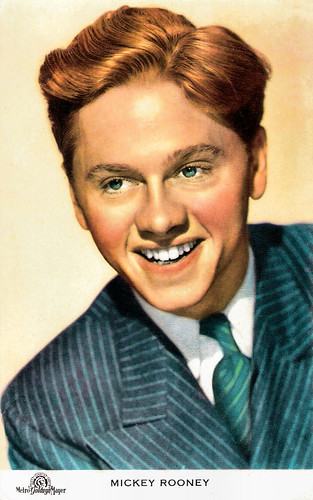
Belgian postcard by Victoria, Brussels, no. 639. Photo: Metro-Goldwyn-Mayer.

Belgian collector's card by Kwatta, Bois d'Haine, no. C. 172. Photo: MGM. Publicity still for Summer Holiday (Rouben Mamoulian, 1948) with Gloria DeHaven.
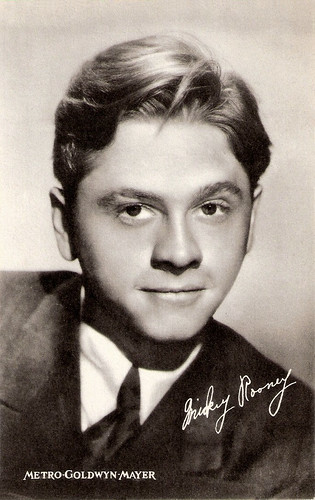
American postcard. Photo: MGM (Metro Goldwyn Mayer).
Mickey Rooney appeared in Andy Hardy Comes Home (Howard W. Koch, 1958), together with his son Teddy Rooney portraying Andy Hardy Jr. Andy Hardy, now a grown man with a wife and children, returns to his hometown on a business trip and finds himself getting mixed up in local politics. In the late 1950s and early 1960s Rooney did a nightclub comedy act with comic Joey Forman.
He also appeared in Breakfast at Tiffany's (Blake Edwards, 1961), starring Audrey Hepburn and George Peppard. Rooney played Hepburn's Japanese neighbour, Mr. Yunioshi. A sign of the times, Rooney played the part for comic relief which he later regretted feeling the role was offensive. He once again showed his incredible range in the dramatic role of a boxing trainer with Anthony Quinn and Jackie Gleason in Requiem for a Heavyweight (Ralph Nelson, 1962). He followed it up with the comedy It's a Mad Mad Mad Mad World (Stanley Kramer, 1963), starring Spencer Tracey.
Rooney regularly worked in European productions, such as the Italian comedy L'arcidiavolo (Errore Scola, 1966) with Vittorio Gassman, British crime comedy Pulp (Mike Hodges, 1972) with Michael Caine, and the Spanish thriller Juego sucio en Panamá/Ace of Hearts (Tulio Demicheli, 1975).
In the late 1960s and 1970s Rooney showed audiences and critics alike why he was one of Hollywood's most enduring stars. He gave an impressive performance in Francis Ford Coppola's The Black Stallion (Carroll Ballard, 1979), which brought him an Academy Award nomination as Best Actor in a Supporting Role. He also turned to the stage in 1979 in Sugar Babies with Ann Miller, and was nominated for a Tony Award. During that time he also portrayed the Wizard in The Wonderful Wizard of Oz with Eartha Kitt at New York's Madison Square Garden, which also had a successful run nationally.
Rooney appeared in four television series: The Mickey Rooney Show (1954-1955), a comedy sit-com in 1964 with Sammee Tong called Mickey, One of the Boys (1982) with Dana Carvey and Nathan Lane, and The Adventures of Black Stallion (1990-1993). In 1981, Rooney won an Emmy Award for his portrayal of a mentally challenged man in Bill (Anthony Page, 1981). The critical acclaim continued to flow for the veteran performer, with Rooney receiving an honorary Academy Award.
Later, he also appeared in such films as Erik the Viking (Terry Jones, 1989) with Tim Robbins, Night at the Museum (Shawn Levy, 2006) with Ben Stiller and The Muppets (James Bobin, 2011) with Amy Adams.
Rooney's personal life, including his frequent trips to the altar, has proved to be just as epic as his on-screen performances. His first wife was one of the most beautiful women in Hollywood, actress Ava Gardner, but his final marriage to Jan Rooney was longer than those of all his other seven wives combined.
In 2012 when he permanently and legally separated from his eighth wife, Rooney chose to permanently reside with his stepson Mark Rooney and Mark's wife Charlene Rooney. They moved to the Hollywood Hills for him. After his death, his eight surviving children said in a statement that they were barred from seeing Rooney during his final years.
Mickey Rooney passed away in 2014 in North Hollywood, Los Angeles. The 93-years-old had at least three future projects that he was going to perform in. His acting career had lasted for 89 years and Rooney's 339 film credits span ten consecutive decades: 1920s-2010s. He is interred at Hollywood Forever Cemetery in Los Angeles, CA.
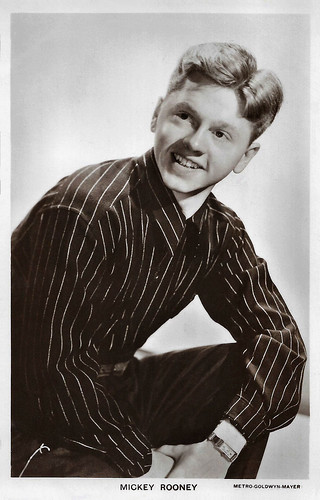
British postcard in the Picturegoer Series, London, no. 902c. Photo: Metro-Goldwyn-Mayer.
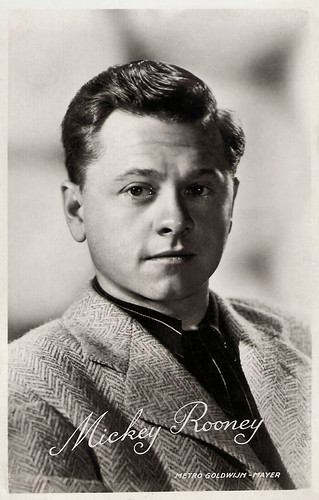
Dutch postcard by 't Sticht, Utrecht, no. 3201. Photo: MGM (Metro-Goldwyn-Mayer).
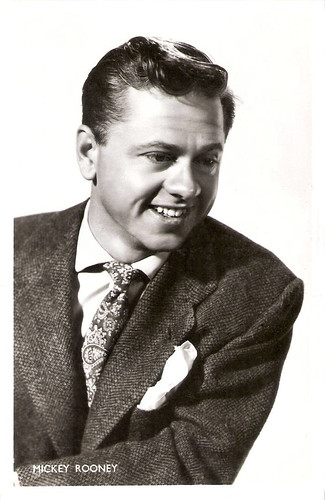
Dutch postcard by Uitgeverij J. Sleeding N.V., Amsterdam, no. S 94. Photo: MGM.
Sources: Wikipedia and IMDb.

British postcard in the Picturegoer Series, London, no. 902a. Photo: Metro-Goldwyn-Mayer.

British postcard in the Picturegoer Series, London, no. 1280. Photo: Metro-Goldwyn-Mayer. Publicity still for Love Finds Andy Hardy (George B. Seitz, 1938) with (back row) Cecilia Parker, Ann Rutherford, Judy Garland, Gene Reynolds, Lana Turner and (front row) Mary Howard, Lewis Stone, Fay Holden and Mickey Rooney.

British postcard in the Picturegoer Series, London, no. 1281. Photo: Metro-Goldwyn-Mayer. Publicity still for Love Finds Andy Hardy (George B. Seitz, 1938) with Ann Rutherford, Judy Garland and Lana Turner.
The popular all-American teenager
Mickey Rooney was born Joe Yule Jr. in 1920 in Brooklyn, New York. He was the son of Scottish-born vaudevillian/actor Joe Yule and Missouri-born Nell Ruth (née Carter) Pankey. Mickey first took the stage in his parents vaudeville act at 17 months old, wearing a specially tailored tuxedo. His parents divorced in 1923, when Mickey was three years old.
In 1925 Mickey came to Hollywood to audition as one of Hal Roach's Rascals for the Our Gang series, but Mickey's mother declined over a dispute over salary. Mickey then made his first film appearance in the short silent comedy Not to Be Trusted (Tom Buckingham, 1926), when he was four years old.He played the character Mickey McGuire for the first time in the bubbly comedy Orchids and Ermine (Alfred Santell, 1927) with Colleen Moore. The following year, he played the lead in the first Mickey McGuire short film, Mickey's Circus (Albert Herman, 1927). It was in this popular film series that he took the stage name Mickey Rooney.
Rooney reached new heights with A Family Affair (George B. Seitz, 1937) with Lionel Barrymore, the film that introduced the country to Andy Hardy, the popular all-American teenager. This beloved character appeared in nearly 20 films and helped make Rooney the top star at the box office in 1939, 1940 and 1941.
Rooney also proved himself an excellent dramatic actor as a delinquent in Boys Town (Norman Taurog, 1938) starring Spencer Tracy as Father Edward Flanagan, an advocate of child rights. In 1938, Rooney was awarded a Juvenile Academy Award.
Teaming up with Judy Garland, Rooney also appeared in a string of musicals, including Babes in Arms (Busby Berkeley, 1939) the first teenager to be nominated for an Oscar for Best Actor in a leading role, Strike Up the Band (Busby Berkeley, 1940), Babes on Broadway (Busby Berkeley, 1941), and Girl Crazy (Norman Taurog, Busby Berkeley, 1943). He and Garland immediately became best of friends. He also appeared with Elizabeth Taylor in National Velvet (Clarence Brown, 1944).
During World War II, Mickey Rooney served 21 months in the U.S. Army, five of them with the Third Army of Gen. George S. Patton. He attained the rank of sergeant and won a Bronze Star, among other decorations. Rooney helped to entertain the troops and worked on the American Armed Forces Network.
He returned to Hollywood and starred in Love Laughs at Andy Hardy (Willis Goldbeck, 1946), did a remake of the James Cagney film The Crowd Roars (Howard Hawks, 1932) called Killer McCoy (Roy Rowland, 1947) and portrayed composer Lorenz Hart in the musical Words and Music (Norman Taurog, 1948).

Belgian postcard by Victoria, Brussels, no. 639. Photo: Metro-Goldwyn-Mayer.

Belgian collector's card by Kwatta, Bois d'Haine, no. C. 172. Photo: MGM. Publicity still for Summer Holiday (Rouben Mamoulian, 1948) with Gloria DeHaven.

American postcard. Photo: MGM (Metro Goldwyn Mayer).
One of Hollywood's most enduring stars
Mickey Rooney appeared in Andy Hardy Comes Home (Howard W. Koch, 1958), together with his son Teddy Rooney portraying Andy Hardy Jr. Andy Hardy, now a grown man with a wife and children, returns to his hometown on a business trip and finds himself getting mixed up in local politics. In the late 1950s and early 1960s Rooney did a nightclub comedy act with comic Joey Forman.
He also appeared in Breakfast at Tiffany's (Blake Edwards, 1961), starring Audrey Hepburn and George Peppard. Rooney played Hepburn's Japanese neighbour, Mr. Yunioshi. A sign of the times, Rooney played the part for comic relief which he later regretted feeling the role was offensive. He once again showed his incredible range in the dramatic role of a boxing trainer with Anthony Quinn and Jackie Gleason in Requiem for a Heavyweight (Ralph Nelson, 1962). He followed it up with the comedy It's a Mad Mad Mad Mad World (Stanley Kramer, 1963), starring Spencer Tracey.
Rooney regularly worked in European productions, such as the Italian comedy L'arcidiavolo (Errore Scola, 1966) with Vittorio Gassman, British crime comedy Pulp (Mike Hodges, 1972) with Michael Caine, and the Spanish thriller Juego sucio en Panamá/Ace of Hearts (Tulio Demicheli, 1975).
In the late 1960s and 1970s Rooney showed audiences and critics alike why he was one of Hollywood's most enduring stars. He gave an impressive performance in Francis Ford Coppola's The Black Stallion (Carroll Ballard, 1979), which brought him an Academy Award nomination as Best Actor in a Supporting Role. He also turned to the stage in 1979 in Sugar Babies with Ann Miller, and was nominated for a Tony Award. During that time he also portrayed the Wizard in The Wonderful Wizard of Oz with Eartha Kitt at New York's Madison Square Garden, which also had a successful run nationally.
Rooney appeared in four television series: The Mickey Rooney Show (1954-1955), a comedy sit-com in 1964 with Sammee Tong called Mickey, One of the Boys (1982) with Dana Carvey and Nathan Lane, and The Adventures of Black Stallion (1990-1993). In 1981, Rooney won an Emmy Award for his portrayal of a mentally challenged man in Bill (Anthony Page, 1981). The critical acclaim continued to flow for the veteran performer, with Rooney receiving an honorary Academy Award.
Later, he also appeared in such films as Erik the Viking (Terry Jones, 1989) with Tim Robbins, Night at the Museum (Shawn Levy, 2006) with Ben Stiller and The Muppets (James Bobin, 2011) with Amy Adams.
Rooney's personal life, including his frequent trips to the altar, has proved to be just as epic as his on-screen performances. His first wife was one of the most beautiful women in Hollywood, actress Ava Gardner, but his final marriage to Jan Rooney was longer than those of all his other seven wives combined.
In 2012 when he permanently and legally separated from his eighth wife, Rooney chose to permanently reside with his stepson Mark Rooney and Mark's wife Charlene Rooney. They moved to the Hollywood Hills for him. After his death, his eight surviving children said in a statement that they were barred from seeing Rooney during his final years.
Mickey Rooney passed away in 2014 in North Hollywood, Los Angeles. The 93-years-old had at least three future projects that he was going to perform in. His acting career had lasted for 89 years and Rooney's 339 film credits span ten consecutive decades: 1920s-2010s. He is interred at Hollywood Forever Cemetery in Los Angeles, CA.

British postcard in the Picturegoer Series, London, no. 902c. Photo: Metro-Goldwyn-Mayer.

Dutch postcard by 't Sticht, Utrecht, no. 3201. Photo: MGM (Metro-Goldwyn-Mayer).

Dutch postcard by Uitgeverij J. Sleeding N.V., Amsterdam, no. S 94. Photo: MGM.
Sources: Wikipedia and IMDb.
No comments:
Post a Comment